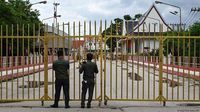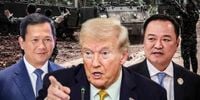As world leaders converge on Kuala Lumpur for the Association of Southeast Asian Nations (ASEAN) summit from October 26 to 28, 2025, the regional bloc finds itself at a crossroads. The summit, hosted by Malaysia in its role as ASEAN's rotating chair, is tackling two of Southeast Asia's most pressing crises: the simmering border conflict between Thailand and Cambodia, and the ongoing civil war in Myanmar. With over 30 heads of state in attendance, including U.S. President Donald Trump, the stakes are high for a region seeking both stability and unity.
The Thai-Cambodian border dispute, which has festered for over a century, erupted into violence this July. According to DW, five days of cross-border combat left at least 43 people dead and displaced 300,000 civilians. Although a ceasefire brokered by Malaysia, China, and the United States took effect on July 29, tensions have not fully abated. Thailand has accused Cambodia of laying new landmines along the frontier, a claim Cambodia denies, attributing recent injuries to old ordnance left over from its own decades-long civil war.
Despite these lingering suspicions, recent diplomatic efforts have yielded cautious optimism. On October 23, just days before the summit, Cambodia and Thailand held their second Special General Border Committee (GBC) meeting in Kuala Lumpur. Co-chaired by Cambodia's Minister of National Defence Tea Seiha and Thailand's Minister Nattaphon Narkphanit, and observed by representatives from Malaysia, the U.S., and ASEAN Interim Observer Teams, the meeting produced a joint statement reaffirming both countries' commitment to peaceful resolution and good-neighborly relations. As reported by Phnom Penh Post, the parties agreed on six key points: the removal of heavy weapons from the border, terms of reference for establishing an ASEAN Observer Team, and standard operating procedures for a Joint Coordinating Task Force (JCTF) on demining.
"Both sides agreed that the JCTF will meet within one week to identify a pilot border area for demining, to be agreed upon by both sides," the joint statement read. The countries also pledged to cooperate in combating transnational crimes such as cyber scams and human trafficking, with a new task force set to be established within two weeks. The GBC will reconvene within 90 days or as needed, with Cambodia hosting the next session.
The diplomatic choreography behind these agreements has been intricate, with Malaysia playing a pivotal role as mediator. Mark S. Cogan, an associate professor of peace and conflict studies at Kansai Gaidai University in Osaka, told DW, "Malaysia has elevated the United States and Trump in the Thai-Cambodia talks, hoping that Washington's added political pressure and economic incentives will be enough for both sides to adhere to the forthcoming declaration." The peace deal, set to be signed at the summit and dubbed the Kuala Lumpur Accord, is expected to formalize these commitments and, it is hoped, lay the groundwork for lasting peace.
U.S. President Donald Trump, never one to shy away from the spotlight, has been actively pursuing this peace deal, blending threats with incentives to bring Thai Prime Minister Anutin Charnvirakul and Cambodian Prime Minister Hun Manet to the table. According to Nikkei Asia, Trump had initially threatened increased trade tariffs on both nations if hostilities continued. The July ceasefire, however, saw Thailand and Cambodia secure a lower tariff rate of 19%. This carrot-and-stick approach, while controversial in some quarters, appears to have nudged both sides toward compromise—though not without resistance. Thailand, long wary of foreign involvement in its bilateral disputes, has had to balance its sovereignty concerns with the practical need for external mediation.
The summit’s agenda, however, is not limited to the Thai-Cambodian border. The civil war in Myanmar looms large over regional discussions. Since a February 2021 military coup ousted Aung San Suu Kyi’s democratically elected government, Myanmar has been engulfed in violence. More than 3.5 million people have been displaced, and thousands have died as opposition groups, people’s defense forces, and ethnic armed organizations battle the military junta. In July 2025, an interim civilian government took power, with plans to hold elections starting December 28. Yet, as junta chief Min Aung Hlaing has admitted, the polls will not be nationwide due to ongoing conflict.
International observers and rights groups have largely dismissed the planned elections as an attempt to legitimize continued military rule. Malaysia, for its part, has argued that the immediate priority should be ending violence and achieving peace, rather than rushing into elections. Sharon Seah, a senior fellow at the ISEAS-Yusof Ishak Institute in Singapore, told DW, "Malaysia will have to put a response to how ASEAN will deal with the December elections in Myanmar because the military has invited some observers, but I don't think ASEAN will send observers."
ASEAN’s own Five-Point Consensus, agreed in 2021, called for an end to violence, mediation, improved dialogue, humanitarian aid, and a visit from a special envoy. Implementation, however, has been lackluster. Myanmar’s military leaders remain banned from high-level ASEAN meetings due to their failure to comply. Malaysian Foreign Minister Mohamad Hasan, quoted by Reuters, insisted that the plan is not difficult to implement and urged Myanmar to allow aid distribution. Yet, as Cogan noted, "It is difficult to see how the situation improves when there are two different sides of ASEAN—states that are firmly in the isolation camp, and those that have moved toward engagement." He added, "Unless ASEAN norms shatter soon, there's little chance of traction coming out of the summit."
Despite these daunting challenges, the summit is not without its bright spots. On October 26, Timor-Leste will become ASEAN's eleventh full member, marking a significant milestone for the bloc. Timor-Leste first applied for membership in 2011, and its accession is seen as a testament to ASEAN’s continued relevance and appeal, even as it grapples with internal divisions and external pressures.
As the Kuala Lumpur summit unfolds, the world will be watching to see whether ASEAN can move beyond rhetoric and deliver tangible progress on its thorniest issues. The Thai-Cambodian peace process, with its blend of regional mediation and great-power involvement, offers a glimmer of hope. Myanmar’s crisis, by contrast, remains a sobering reminder of the limits of consensus diplomacy in the face of entrenched conflict. For ASEAN, the challenge is clear: to prove that unity and pragmatism can still prevail in a turbulent region.


